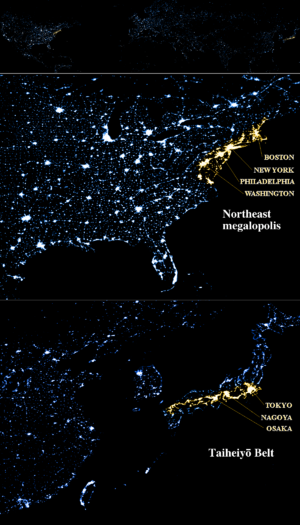Megalopolis facts for kids

A megalopolis (/ˌmɛɡəˈlɒpəlɪs/) or a supercity, also called a megaregion, is a group of metropolitan areas which are perceived as a continuous urban area through common systems of transport, economy, resources, ecology, and so on. They are integrated enough that coordinating policy is valuable, although the constituent metropolises keep their individual identities. The megalopolis concept has become highly influential as it introduced a new, larger scale thinking about urban patterns and growth.
Etymology and earlier definitions
The term comes from the Greek word megalo-polis (big city), and has specific geographic definitions dating from 1832, when its meaning was "a metropolis," that is, "a very large, heavily populated urban complex".
In the late 1950s and early 1960s, Jean Gottmann, a professor of political science at the University of Paris and member of the Institute for Advanced Study at Princeton, directed "A Study of Megalopolis" for The Twentieth Century Fund, wherein he described a megalopolis as a "world of ideas". Gottmann, in his extensive studies, applied the term megalopolis to an analysis of the urbanized northeastern seaboard of the U.S., in particular from Boston, Massachusetts to Washington, D.C. (the Northeast megalopolis).
Modern definitions
A megalopolis may also be called a megaregion. "Megalopolis" and other similar terms have been used by different scholars and countries to describe similar spatial forms.

A megalopolis, following the work of Gottmann, refers to two or more roughly adjacent metropolitan areas that, through a commonality of systems—e.g., of transport, economy, resources, and ecologies—experience a blurring of the boundaries between the population centers, such that while some degree of separation may remain, their perception as a continuous urban area is of value, e.g., "to coordinate policy at this expanded scale". Simply put, a megalopolis (or a megaregion) is a clustered network of big cities. Gottmann defined its population as 25 million, while Doxiadis defined a small megalopolis a similar cluster with a population of about 10 million. America 2050, a program of the Regional Plan Association (RPA), lists 11 megaregions in the United States and Canada.
Megaregions of the United States were explored in a July 2005 report by Robert E. Lang and Dawn Dhavale of the Metropolitan Institute at Virginia Tech. A later 2007 article by Lang and Nelson uses 20 "megapolitan" areas grouped into 10 megaregions. The concept is based on the original "Megalopolis model".
Modern interlinked ground transportation corridors, such as rail and highway, often aid in the development of megalopolises. Using these commuter passageways to travel throughout the megalopolis is informally called megaloping, a term coined by Davide Gadren and Stefan Berteau.
In Brazil, the term megarregião has a legal meaning, different from the English word megaregion: mesoregions of Brazil (mesorregião) and microregions of Brazil (microrregião).
In China, the official term corresponding to the meaning of "megalopolis" is '城市群' (chéngshì qún), which, in Chinese, was originally coined by Yao Shimou and literally means "city cluster". A "city cluster" is defined as "[a]n area in which cities are relatively densely distributed in a certain region". In an older standard, the term was mistranslated as "agglomeration". In 2019, National Development and Reform Commission (NDRC) published guidelines and made a distinction from a similar concept "metropolitan area" (都市圈), which is of a smaller scale than a city cluster. In the latest standard terminologies of both economics and urban planning, 城市群 is translated as "city cluster", replacing "agglomeration". Megalopolises in China have become the subject of national government planning.
List of megalopolises
See also
- Arcology
- Conurbation
- Ecumenopolis
- Ekistics
- Settlement types:
- Hamlet
- Village
- Town
- City
- Metropolis
- Classification of inhabited localities in Russia
- Global city
- Merger (politics)
- Transborder agglomeration
- Urban area
- Developed environments:


